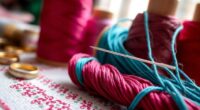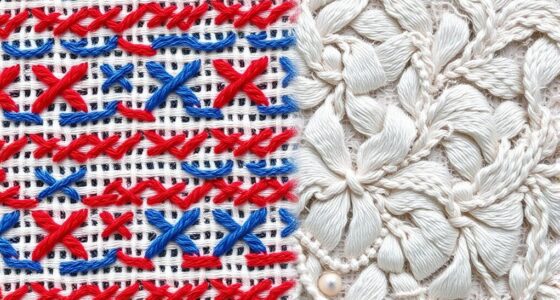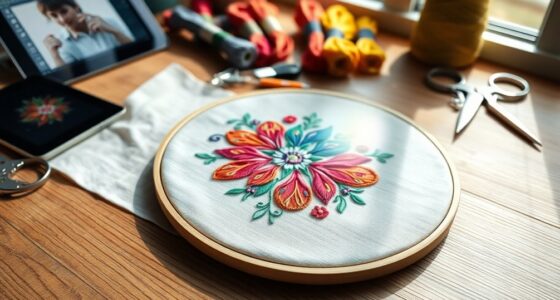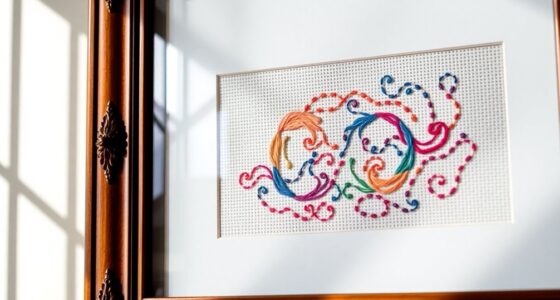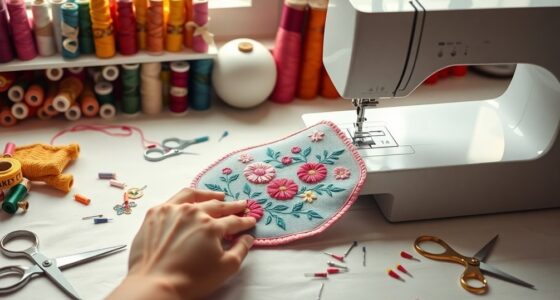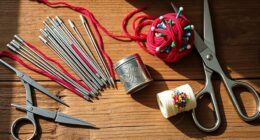To transfer your embroidery pattern, you can use several effective methods. Start with tracing techniques using a removable fabric marker, or try iron-on methods with heat-sensitive paper. Water-soluble stabilizers work well for detailed designs. Alternatively, carbon paper lets you easily trace patterns, while stencils can help create clean outlines. Finally, direct printing on fabric offers a modern approach. Keep exploring to find the perfect technique that fits your project needs!
Key Takeaways
- Use tracing techniques with removable fabric markers to ensure precise design transfer onto fabric.
- Try iron-on methods by tracing designs onto heat-sensitive paper for easy application on various fabric weights.
- Explore water-soluble stabilizers for detailed transfers that can be washed away after stitching.
- Employ carbon paper for a cost-effective and accurate method of transferring designs to different fabric types.
- Utilize stencils secured with removable tape to create clean and precise outlines for painting or marking on fabric.
Tracing Techniques
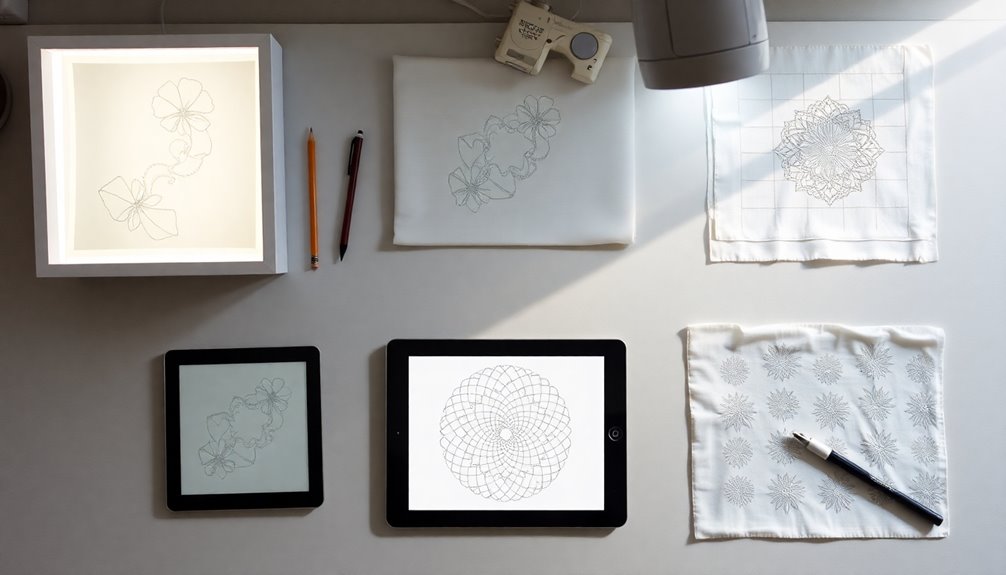
Tracing techniques are an excellent way to transfer embroidery patterns, especially on lightweight fabrics where visibility is key. To get started, use a light source like a light box or window to see your design clearly.
Opt for a removable fabric marker, such as a Frixion pen, to guarantee easy erasure after stitching. When you use tracing paper, baste the paper onto the fabric for precise transfer without soaking later.
If you prefer freehand sketching, fabric-safe markers allow direct drawing onto the fabric for creative flexibility. Always test different pens on a scrap piece to confirm the ink's removability and verify it's compatible with your fabric type.
This way, you'll avoid any unpleasant surprises during your project.
Iron-On Methods
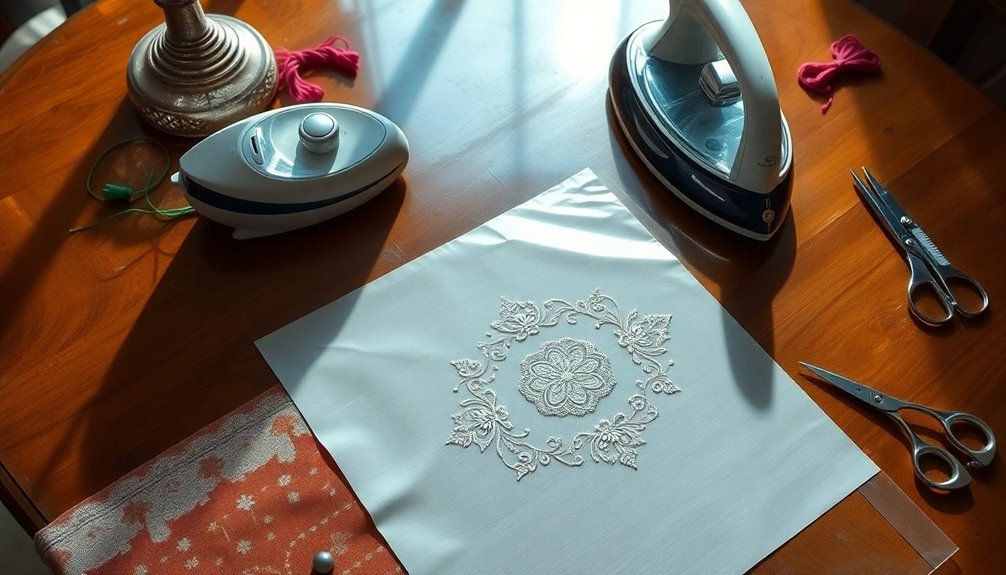
If you're looking for another reliable way to transfer your embroidery patterns, iron-on methods offer a straightforward solution.
Start by tracing the design onto heat-sensitive paper in reverse. Using a heat transfer pen or pencil, carefully press the design onto your fabric using a hot iron, creating a permanent transfer. This technique works well on both light- and heavy-weight fabrics, making it versatile for different projects.
However, it's best suited for simple designs, as intricate details may not transfer effectively. Always test the heat transfer on a scrap piece of fabric to verify you achieve the desired results.
Remember to lift the iron between placements to avoid distorting your design lines for a clean finish.
Water-Soluble and Wash-Away Techniques
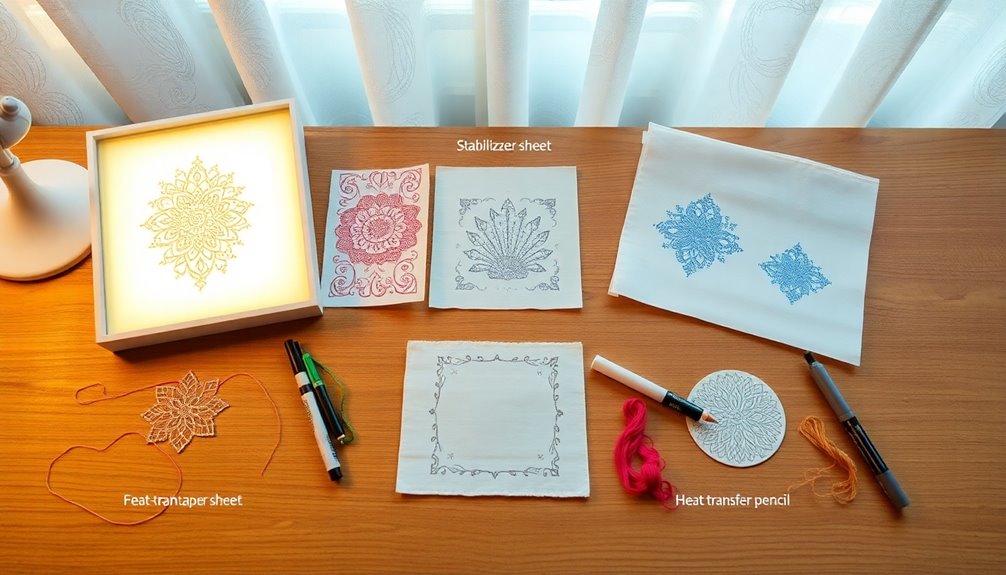
Water-soluble and wash-away techniques provide a fantastic option for transferring intricate embroidery patterns. Using water-soluble stabilizers guarantees a detailed transfer without residual marks, especially on dark fabrics.
Here's how you can effectively use these methods:
- Print your pattern directly onto the water-soluble stabilizer.
- Baste the stabilizer onto your fabric, placing it on top during the embroidery process.
- After stitching, soak your finished piece in warm water to dissolve the stabilizer.
- Confirm your fabric is washable and your embroidery floss is colorfast to maintain fabric visibility.
These transfer techniques not only enhance your design but also make the embroidery process cleaner and more efficient, leaving you with stunning results. As you explore a variety of transfer techniques, you’ll discover how they can be adapted for different materials and styles, allowing for greater creativity in your projects. This adaptability is especially important as trends evolve, making it essential to stay informed about the types of embroidery designs in 2025 that capture contemporary aesthetics. With the right techniques, you’ll be well-equipped to bring your unique vision to life and keep your work ahead of the curve.
Carbon Paper and Pattern Transfer Methods
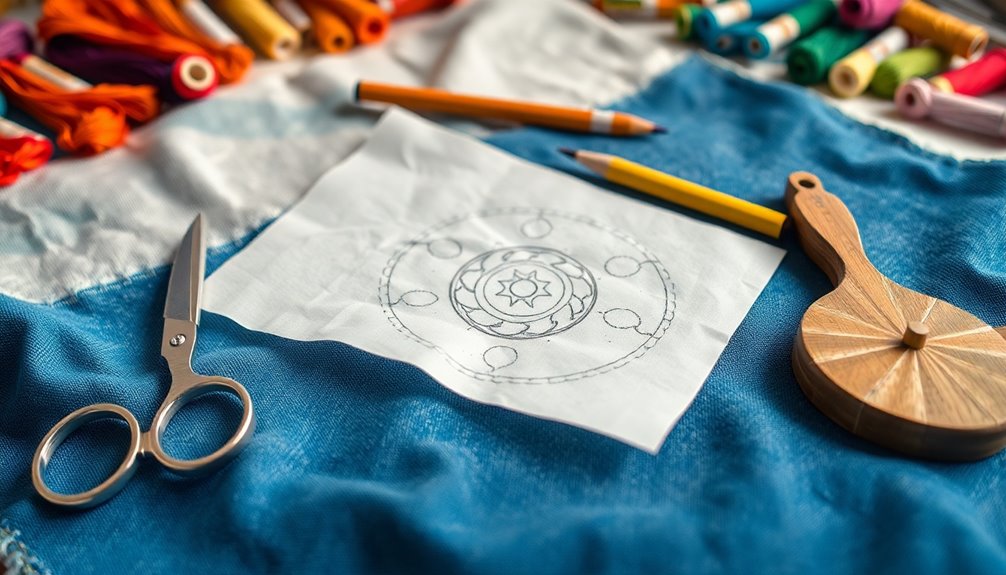
After exploring water-soluble and wash-away techniques for transferring embroidery patterns, you might want to contemplate the carbon paper method, which offers a straightforward and effective alternative.
This transfer method involves placing carbon paper between your design and fabric, with the colored side facing the fabric. For dark fabrics, use light-colored carbon paper, while dark paper works best on light fabrics.
To guarantee an accurate transfer, use a stylus or fine-tipped pen to trace the design. It's wise to practice on a scrap piece of fabric first to check for any residue issues.
With practice, you'll find this cost-effective method allows for precise designs to be transferred seamlessly onto various fabric types.
Stencil and Tape Techniques

While exploring different methods for transferring embroidery patterns, consider using stencil and tape techniques for a clean and efficient approach. This method works great for repetitive designs, ensuring consistent application.
Here's how to get started:
- Create or purchase stencils that fit your design.
- Secure the stencil to your fabric using removable tape to keep edges clean.
- Use fabric-safe paint or markers to fill in the stencil outlines, ensuring precision.
- Illuminate your work area with a light source to easily see the stencil outlines.
Before tackling your final project, practice on scrap fabric to refine your application technique. This will help you achieve satisfactory results and elevate your embroidery work!
Direct Printing Methods
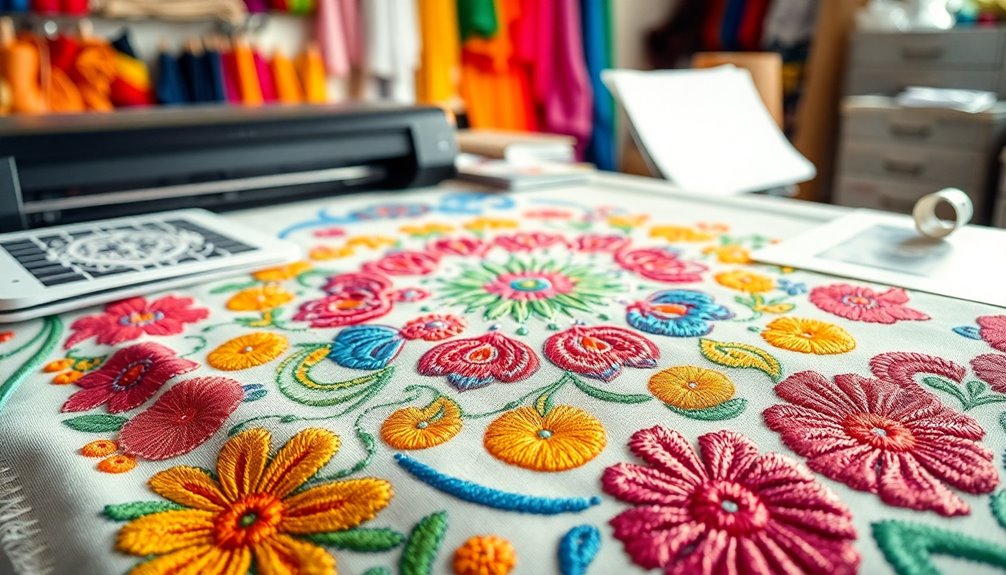
If you're looking for an efficient way to transfer embroidery patterns, direct printing methods can be a game-changer. Using ink jet printers, you can quickly and precisely transfer designs onto compatible fabric without the hassle of manual tracing.
Before you start, make sure to test your fabric's compatibility, as not all fabrics hold ink well or can withstand the heat required for proper transfer. Place the ink side of the printed paper against the right side of the fabric for the best results.
Some fabrics may need special treatment or adhesive backing to enhance ink adherence, so always opt for high-quality fabric for ideal results. Keep in mind, you'll need multiple prints for larger designs, as printer sizes typically limit you to A4.
Frequently Asked Questions
What Are the Methods of Transferring Embroidery Designs?
When you're looking to transfer embroidery designs, you've got several effective methods at your disposal.
You can trace designs using light sources, apply heat transfer pens for permanent results, or print directly onto water-soluble stabilizers for intricate patterns.
Carbon paper and pattern transfer papers are great for imprinting designs, while the prick and pounce method works well for dark fabrics.
Choose the one that suits your project best and get started!
How to Transfer Embroidery Pattern Onto Dark Fabric Without Transfer Paper?
You've got a dark fabric and a vibrant design; now it's time to bring that vision to life!
You can outline the pattern with a fine point permanent marker, ensuring it won't bleed.
You can prick and pounce using powdered pigment, or you can place dressmaker's carbon paper under your design and trace it.
You can also use a heat transfer pen, tracing in reverse before applying heat to set your masterpiece.
What Is the Easiest Among the Three Methods of Transferring Designs on Fabric?
When deciding on the easiest method to transfer designs onto fabric, you'll find that using pre-printed designs or iron-on transfers is often the simplest choice.
These require no extra steps, allowing you to jump right into stitching. If you prefer a bit more customization, tracing designs with a light source also offers clarity and straightforward application.
Ultimately, your choice depends on your comfort level and the fabric type you're working with.
How Do I Transfer Embroidery Patterns From My Computer to My Machine?
To transfer embroidery patterns from your computer to your machine, start by checking if your machine supports the file format you're using.
Use embroidery software to adjust your design, then connect your machine to your computer via USB or use a USB flash drive.
Follow your machine's instructions to load the pattern.
Always test on scrap fabric first to guarantee everything stitches correctly before you begin your final project.
Conclusion
Now that you've explored these six ways to transfer your embroidery patterns, you can choose the method that suits you best. Whether you prefer tracing, iron-on techniques, or even direct printing, each option offers unique benefits. Imagine how effortless your projects will become when you find the right technique! So, which method will you try first to bring your creative visions to life? Embrace the process and watch your embroidery skills flourish!

